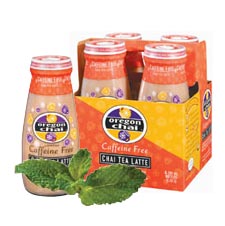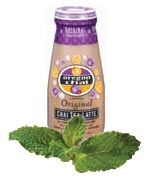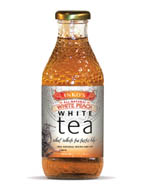
"Dairies are steeped in a tradition of handling sensitive products with great care and respect," says Susan Brady, sales mgr., Templar Food Products, New Providence, N.J. "Natural products such as milk . . . and tea, require finely honed skills and good manufacturing practices that are a consistent and an established part of each and every manufacturing shift."
Joe Allen, pres., Allen Flavors Inc., Edison, N.J., says, "And to add iced tea to a dairy's beverage line costs practically nothing. Plus, iced tea is a major profit center for dairies that produce it."
Indeed, dairies producing single-serve milk have the fillers and bottles. They also have refrigerated distribution, which is what makes dairy-produced iced tea superior tasting to the many shelf-stable offerings in the marketplace.
"Dairies pioneered the manufacturing techniques crucial to the quality of iced teas with pasteurization tunnels and high-temperature, short-time (HTST) processing," says Brady. "Dairies are so keenly in tune with the importance of sanitation and shelflife that they take a good tea and turn it into a great tea. Dairies are positioned as major players in the profitable arena of ready-to-drink tea."
Steve Lowrey, assistant v.p., Red Diamond, Birmingham, Ala., concurs. "Dairies are a great fit. Because the way to make great-tasting iced tea is to keep it refrigerated," he says. "Obviously, dairies are already handling time- and temperature-sensitive products."
Brady adds, "With a valuable and expensive network of refrigerated distribution already in place, dairies are ideally set up to produce iced tea that is shipped cold, sold cold, and, as it must be in the end, sipped cold."

Dairies, and tea preferences, are both regional
"Southerners take their sweet iced tea pretty seriously," says Lowrey. "I once heard someone call sweet tea ‘the table wine of the South.'"Allen adds, "There are also variations in brew strength and tea pucker. Because dairies typically cater to regions, it is a perfect fit. They have the upper hand over a nationally branded shelf-stable product."
Indeed, for true iced tea connoisseurs, the nationally branded, shelf-stable iced teas just don't cut it.
Dairies have some options when it comes to choosing tea products. "They can bottle a fresh-brewed tea, very much like what you would brew at home," says Lowrey.
They can also use tea syrups or soluble or instant tea pre-mixes. Pre-mixes contain tea, as well as flavors such as lemon, peach, orange or raspberry. Dairies simply measure off how much mix they need, add sweetener and process like fluid milk. In low-calorie or diet formulations, the high-intensity sweetener is part of the pre-mix.

Why include tea?
So, if a dairy decides to grow its beverage line, why should tea be included?According to the "Tea is ‘Hot' Report," 5th edition, from Sage Group International, Seattle, specialty teas, including flavored iced tea beverages, are poised for continued high-paced growth. In fact, the tea industry has grown from less than $1 billion in annual sales around 1990, to more than $5 billion in 2003. Much of that was due to the high performance of ready-to-drink teas in the later 1990s and early 2000s.
"Tea is the beverage of choice for health conscious, on-the-go consumers," says Gretchen Schleck, marketing communications coordinator, Robertet Flavors, Piscataway, N.J. "This category's growth continues to be driven by several factors including extensive media coverage of proven health benefits of tea consumption."
It is the polyphenols in tea that are responsible for the antioxidant activity that everyone is talking about. In fact, the pure catechins and phenolic acids found in tea have been found to be more powerful than the antioxidant group of vitamins C, E and beta-carotene in an in vitro lipoprotein oxidation model. This information is turning more Americans onto tea, with a great deal of interest in green tea.
Not surprisingly, in Japan, a top tea-consuming Asian country, bottled green tea surpasses sales of bottled water. Since the 1980s, ITO EN, a leading Japanese supplier of green tea leaves and green tea beverages, has steadily grown the ready-to-drink tea beverage market in Japan, and is now trying to grow it here too.
Imported into the United States from Japan, ITO EN Teas' Tea™ shelf-stable ready-to-drink teas are packaged in polyethylene terepthylate (PET) bottles with shrink-wrap label. Sold in the beverage aisle, these teas come in a range of varieties including green, jasmine, oolong and white, along with blends. Some teas are sweetened while others are not.
The unsweetened Golden Oolong variety includes 110% of the Daily Value for vitamin C, with the ascorbic acid added for preservation. Described with the tagline: Drink for yourself™, labels include the following supporting information: "Gifts for the human body. Oolong tea and vitamin C. Nothing more. Nothing less. Refreshingly simple. Drink. And let your body rejoice."
Domestically, AriZona Beverage Co., Lake Success, N.Y., and Snapple Beverage Group, White Plains, N.Y., might still be the largest non-dairy iced tea manufacturers, but they are no longer without competition.
Inko's LLC, New York City, is dedicated to producing ready-to-drink white tea beverages. Continuing medical research is being conducted to examine the potential health properties in white tea and some studies show that white tea has a higher level of antioxidants than green tea, potentially making it a superior cancer fighter.
"Perhaps a blessing in disguise, Inko's does not have the means nor the inclination to throw five or 10 flavors at once at consumers to see what sticks," says Andrew Schamisso, founder and pres. "Instead, we take the time to gather feedback from our customer base and test and test again."
Inko's white tea beverages are either unsweetened or slightly sweetened with fructose crystals-not corn syrup-keeping calories low, according to the company. Inko's first offering was Original White Tea, with fewer than 60-calories per 16-oz bottle. Calorie-free Unsweetened Hint O' Mint White Tea came next. In addition to white tea, it is made with fresh-cut ginger and fresh whole-mint sprigs. Most recently, the company rolled out a White Peach White Tea, which has the same amount of calories as Original. The drink is made using 100% all-natural white peach extract.
Other fruits are making their way into iced tea. The Atlantic Blueberry Co., Hammonton, N.J., combines the health benefits associated with blueberries with those of tea in its new blueberry iced tea that is made with natural blueberry juice concentrate.
And AriZona is doing the same, while taking its new fruited iced teas a step further with new AriZona Net No-Carb Green Teas in two flavors: Blueberry Green Tea and White Cranberry Apple Green Tea.
"Exciting new flavor combinations are making their way into mainstream tea bottles alongside the core lemon-, peach- and raspberry-flavored teas, says Schleck. "While black tea is the dominant tea in ready-to-drink tea beverages, other varietal teas are gaining market share including green, oolong and white. Red tea, also known as rooibos, is an herbal tea that is becoming quite popular both here and abroad."
Rooibos (pronounced ROY-boss), has been a favorite herbal tea among South Africans for years. The beverage is rich in antioxidants and vitamin C, and is caffeine-free. It is made from Aspalathus linearis, an indigenous shrub that grows only in the mountainous region close to the Cape of Good Hope.
Closer to home, and back on the course, let's not forget "The Arnold Palmer," the famous lemonade and iced tea drink named after its golf-great inventor. Thanks to ingredient suppliers, it is possible for dairies to purchase a pre-mixed blend of lemonade with iced tea for easy processing and filling.
And that's what it is
all about . . . it's easy
for dairies to make iced tea. So easy (and profitable), in fact, that you can squeeze in a different tee time before or after work and not feel guilty!
Sidebar: True Tea Varieties
There are around 3,000 varieties of "true" tea, but they all come from the same evergreen plant- Camellia sinensis. This plant was identified as having beverage qualities when some of its leaves blew into the water that Chinese Emperor Shen-Nung was boiling in 2737 BC. When he drank the mixture, he declared that it gave him vigor of body, contentment of mind and determination of purpose, claims still around today.Tea varieties are classified by the manner in which the leaves are processed after plucking. The four most common varieties are:
- Black tea is defined as freshly plucked leaves that are withered indoors in open-air shelves without any physical breaking of the leaf structure. After withering the leaves are rolled, exposing the enzymes in the leaf to the atmosphere, allowing them to ferment. At a critical point, the fermenting tea leaves are fired at high heat to stop the fermentation process.
- Green tea refers to plucked leaves that are not fermented. Rather, the leaves are steamed or otherwise heated immediately after plucking to prevent the fermentation that makes black tea. These leaves are then rolled and dried.
- Oolong tea is fermented only partially, to a point between black and green teas. While the leaves wilt naturally, enzymes begin to ferment them. Processors interrupt the fermentation by stirring the leaves in heated pans, then rolling and drying them.
- White tea, like green tea, is not fermented. White tea leaves are allowed to dry completely in the sun without any pan frying or steaming, resulting in a purer, natural state. During plucking, great care is given to the selection of leaves. Usually only the youngest leaves, which are still covered with down (short white hair), are used. The absence of withering, rolling and oxidation keeps the appearance of the leaves intact, and because the silvery down is still visible, leaves look white in color.

Sidebar: Combining Milk with Tea
Just like folks add cream to their coffee, milk is the perfect complement for tea, too.A tea beverage that originated in Taiwan some 20 years ago is bubble tea. This drink is typically made-to-order, much like original smoothies, and combines tea with other flavors, milk and large hydrated black tapioca pearls that have a chewy consistency similar to gummy jellied candies. Added flavors range from tropical fruits to more ethnic flavors including red bean and sesame. Special, large-diameter straws accommodate the large tapioca pearls.
In Chicago's Vong's Thai Kitchen, world-class chef Jean Georges Vongerichten has created a Blueberry Bubble Tea. Using fresh blueberries and sugar syrup, he makes a smoothie base to which tapioca balls are added. To intensify the blueberry flavor, the tapioca balls are made with real blueberries.
Chai is a centuries-old Asian beverage that is typically served hot, but since being modernized, is frequently consumed cold, particularly in the United States. It is a blend of milk, fine black teas, honey and a variety of spices, which vary by region and culture. Typically, cardamom, ginger and even pepper are used as spices.
Recently a ready-to-drink form became available from Oregon Chai, Portland, Ore. Chai Tea Lattes, in original and caffeine-free varieties, are a blend of rooibos tea, milk, vanilla, honey and spices.